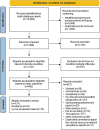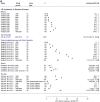Incidence of Lyme Borreliosis in Europe: A Systematic Review (2005-2020)
- PMID: 37071407
- PMCID: PMC10122234
- DOI: 10.1089/vbz.2022.0070
Incidence of Lyme Borreliosis in Europe: A Systematic Review (2005-2020)
Abstract
Background: Lyme borreliosis (LB) is the most common tick-borne disease in Europe, but the burden of disease is incompletely described. Methods: We conducted a systematic review across PubMed, EMBASE, and CABI Direct (Global Health) databases, from January 1, 2005, to November 20, 2020, of epidemiological studies reporting incidence of LB in Europe (PROSPERO, CRD42021236906). Results: The systematic review yielded 61 unique articles describing LB incidence (national or subnational) in 25 European countries. Substantial heterogeneity in study designs, populations sampled, and case definitions restricted data comparability. The European Union Concerted Action on Lyme Borreliosis (EUCALB)-published standardized LB case definitions were used by only 13 (21%) of the 61 articles. There were 33 studies that provided national-level LB incidence estimates for 20 countries. Subnational LB incidence was available from an additional four countries (Italy, Lithuania, Norway, and Spain). The highest LB incidences (>100 cases per 100,000 population per year [PPY]) were reported in Belgium, Finland, the Netherlands, and Switzerland. Incidences were 20-40/100,000 PPY in the Czech Republic, Germany, Poland, and Scotland and <20/100,000 PPY in Belarus, Croatia, Denmark, France, Ireland, Portugal, Russia, Slovakia, Sweden, and the United Kingdom (England, Northern Ireland, and Wales); markedly higher incidences were observed at the subnational level (up to 464/100,000 PPY in specific local areas). Conclusions: Although countries in Northern (Finland) and Western (Belgium, the Netherlands, and Switzerland) Europe reported the highest LB incidences, high incidences also were reported in some Eastern European countries. There was substantial subnational variation in incidence, including high incidences in some areas of countries with low overall incidence. This review, complemented by the incidence surveillance article, provides a comprehensive view into LB disease burden across Europe that may guide future preventive and therapeutic strategies-including new strategies on the horizon.
Keywords: Europe; Lyme Borreliosis; epidemiology; incidence; systematic review.
Conflict of interest statement
J.H.S., F.J.A., B.D.G., A.P., A.V., M.A.F., and J.C.M. are all employees of Pfizer and may hold stock/shares in Pfizer. L.B. and T.M.P.T. declare no conflicts of interest.
Figures






References
-
- Adlhoch C, Poggensee G. Lyme-borreliose: ein situationsbericht aus den sechs östlichen Bundesländern 2007–2009. Robert Koch Institut, 2010; pp. 5–8; doi: 10.25646/654 Available from: https://edoc.rki.de/handle/176904/729 [Last accessed: January 14, 2023]. - DOI
-
- Bochničková M, Szilágyiová M, Gardlík R. Lyme borreliosis—Epidemiological analysis of incidence in the northern region of Slovakia. Epidemiol Mikrobiol Imunol 2012;61:3–8. - PubMed
Publication types
MeSH terms
LinkOut - more resources
Full Text Sources
Medical
